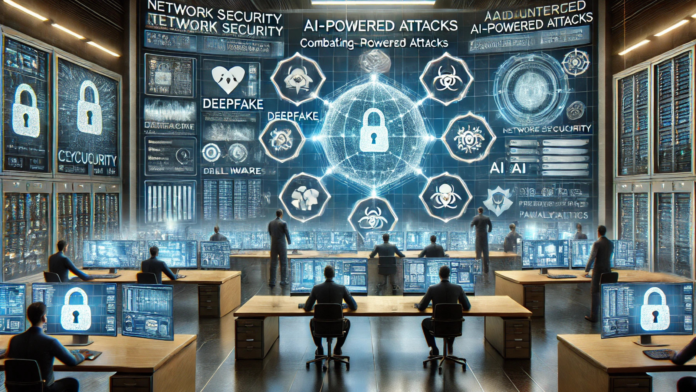As artificial intelligence (AI) rapidly integrates into diverse sectors, cybercriminals are also leveraging AI to enhance the scope, speed, and effectiveness of their attacks. This surge in AI-powered threats is prompting cybersecurity professionals and organizations worldwide to adopt sophisticated countermeasures. The latest developments in cybersecurity reveal a growing focus on AI-powered defense strategies, advanced threat detection, and regulatory frameworks aimed at curbing the unique risks associated with AI-driven cyberattacks.
The Rise of AI-Powered Cyber Threats
AI-powered attacks represent a new frontier in cybersecurity threats. Unlike traditional malware or phishing attempts, AI-driven attacks can dynamically adapt, often using machine learning (ML) to refine their approach. These attacks are characterized by:
1. Automated Phishing and Social Engineering: AI can be trained to analyze data from social media and other public sources to create highly personalized phishing schemes. This approach increases the likelihood of victims falling for these sophisticated attempts.
2. Deepfake and Synthetic Media Attacks: Advances in AI-generated media, such as deepfakes, enable attackers to impersonate individuals, making fraudulent activities such as fake CEO scams more convincing.
3. Advanced Persistent Threats (APTs): Using AI, attackers can develop APTs that evade traditional detection methods. These threats can remain dormant in systems, harvesting sensitive information over extended periods.
4. Weaponized AI Algorithms: Some cybercriminals are designing malicious AI algorithms to probe vulnerabilities, automate tasks that were once manual, and even craft multi-phase attacks with precision.
Cybersecurity Responses to AI-Powered Threats
To combat these sophisticated threats, cybersecurity firms and organizations are adopting proactive, AI-driven defense strategies. Here are some key developments:
1. AI-Driven Threat Detection and Response Systems
Traditional threat detection systems are increasingly being supplemented or replaced by AI-powered tools. These advanced systems use machine learning to identify anomalies in real-time, often detecting unusual behaviors that would otherwise go unnoticed. For instance:
– Behavioral Analysis: AI can create baseline profiles of user and network activity, quickly identifying deviations that may signal a cyberattack.
– Self-Learning Systems: Some cybersecurity systems now employ self-learning algorithms that adapt to new threats autonomously, enabling real-time responses to rapidly evolving attacks.
– Predictive Threat Intelligence: By analyzing historical data and attack patterns, predictive AI systems can forecast potential vulnerabilities and recommend preemptive measures.
2. Generative Adversarial Networks (GANs) for Defense
Originally developed for image synthesis, GANs are now being utilized in cybersecurity to enhance defenses. By simulating real-world attack scenarios, cybersecurity teams can use GANs to identify potential vulnerabilities before they are exploited. This is particularly effective in:
– Network Security Testing: GANs are used to generate simulations of network breaches, allowing IT teams to observe how AI-powered attacks might behave in a controlled environment.
– Anticipating AI-Driven Tactics: GANs can help predict how AI might adapt during a prolonged attack, providing critical insights for preemptive measures.
3. AI-Augmented Endpoint Protection
As work-from-home and hybrid models become more common, endpoint security has gained renewed importance. AI-augmented endpoint protection focuses on securing devices and access points connected to corporate networks, preventing AI-powered malware from spreading. Key innovations include:
– Real-Time Malware Detection: Machine learning algorithms now enable real-time analysis of files and applications, allowing for the immediate detection and quarantine of suspicious activities.
– Zero-Trust Frameworks: AI enhances zero-trust security models, where every device and application attempting to access a network must first be authenticated and continuously monitored.
4. Collaboration and Regulatory Developments
AI-driven attacks pose challenges that require international cooperation and regulatory oversight. Governments and private sectors are increasingly collaborating to develop standards for AI safety and ethical usage. Notable initiatives include:
– Regulatory Standards: In response to AI’s dual-use nature, some governments are developing regulations for responsible AI usage and setting up penalties for AI misuse in cyberattacks.
– Cross-Industry Collaboration: Many cybersecurity firms are now part of AI task forces that share information about emerging threats. This real-time information sharing enhances global threat intelligence and contributes to building resilient defenses.
5. Quantum Computing and AI-Enhanced Cryptography
Quantum computing promises to revolutionize cybersecurity by enabling new forms of cryptographic protection. Quantum AI can be employed to strengthen encryption algorithms, making it exceedingly difficult for AI-driven attacks to decrypt sensitive information. Though still in the early stages, quantum-enhanced AI is expected to play a critical role in cybersecurity in the coming years.
The Future of Cybersecurity in an AI-Dominated Landscape
The evolving landscape of AI-powered cyber threats demands an equally innovative response. While AI is empowering attackers with new tools, it is also equipping cybersecurity experts with the means to predict, prevent, and mitigate these risks. Organizations that adopt AI-driven defense systems and proactive policies will be better prepared to face this new wave of cyber threats.
As AI continues to evolve, the emphasis will shift toward responsible AI development, robust cybersecurity practices, and ongoing adaptation to the latest technologies. It’s clear that in the cat-and-mouse game of cybersecurity, both attackers and defenders will continue to leverage AI in unprecedented ways. The challenge now lies in staying one step ahead, ensuring that AI’s potential is harnessed for protection and resilience in the digital age.




















